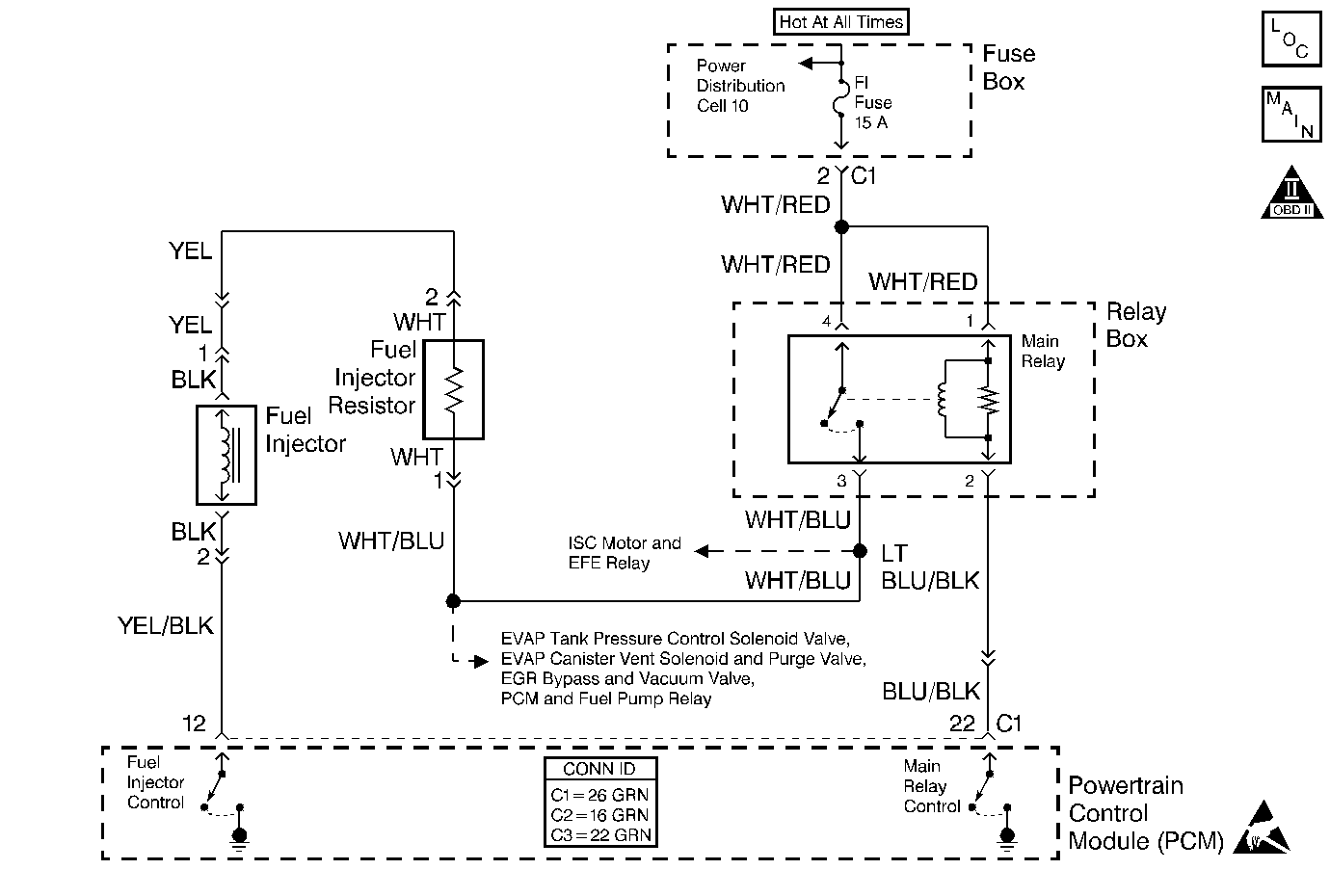
Circuit Description
The powertrain control module (PCM) energizes the solenoid coil of the fuel injector. When energized the fuel injector solenoid operates the solenoid plunger allowing pressurized fuel to be injected into the bore of the throttle body fuel injection unit. The fuel pump will pressurize the fuel injector as long as the engine is cranking, and the PCM is receiving ignition system reference pulses. The fuel pump will stop after 2 seconds if the PCM does not receive any ignition system reference pulses.
Diagnostic Aids
Check for a faulty fuel injector. There may be fuel spray at the fuel injector, but it may not be enough to start the engine. Normal fuel injector resistance is 0.5-1.5 ohms at 20°C (68°F). Check for a partially blocked fuel injector nozzle if both the fuel injector solenoid and the fuel injector circuit are OK.
Check the fuel injector resistor for faulty electrical connections or high electrical resistance. Normal fuel injector resistor resistance is 1.9-2.8 ohms at 20°C (68°F).
An intermittent malfunction may be caused by a fault in the fuel injector electrical circuit. Inspect the wiring harness and components for any of the following conditions:
| • | Backed out terminals. |
| • | Improper mating of terminals. |
| • | Broken electrical connector locks. |
| • | Improperly formed or damaged terminals. |
| • | Faulty terminal to wiring connections. |
| • | Physical damage to the wiring harness. |
| • | Broken conductor inside the wire insulation. |
| • | Corrosion of electrical connections, splices, or terminals. |
Test Description
The numbers below refer to the step numbers in the Diagnostic Table.
-
The Powertrain OBD System Check prompts the technician to complete some basic checks and store the freeze frame data on the scan tool if applicable. This creates an electronic copy of the data taken when the fault occurred. The information is then stored in the scan tool for later reference.
-
This step checks if the PCM is controlling the fuel injector signals.
-
This step checks the fuel injector for the correct resistance.
-
This step checks for voltage at the fuel injector.
-
This step checks for an open or a short to ground in fuel injector control circuit, for a faulty PCM, or for a faulty fuel injector.
-
This step checks for an open in the YEL wire, an open in the ignition feed circuit or for a faulty fuel injector resistor.
Step | Action | Value(s) | Yes | No |
|---|---|---|---|---|
Did you perform the Powertrain On-Board Diagnostic System Check? | -- | |||
Does the fuel injector test lamp flash while the engine is cranking? | -- | |||
Measure the resistance of the fuel injector (fuel injector side) with a DMM. Is the resistance within the specified value? | 0.5 to 1.5 ohms at 20°C (68°F) | |||
4 |
Important: The fuel injector may or may not have fuel spray. Check for fuel restrictions or for a partly blocked fuel injector nozzle and repair as necessary. Refer to Throttle Body Assembly Overhaul . Was a repair necessary? | -- | ||
Is the injector test lamp ON all the time while cranking the engine? | -- | |||
Was a repair necessary? | -- | |||
7 |
Is the voltage near the specified value? | B+ | ||
8 | Connect a test lamp from the fuel injector electrical connector cavity 2 to B+ (harness side). Does the test lamp flash while engine is cranking? | -- | ||
9 |
Was a repair necessary? | -- | ||
10 | Replace the fuel injector. Refer to Fuel Injector Replacement . Is the action complete? | -- | -- | |
11 |
Was a repair necessary? | -- | ||
12 | Replace the PCM. Refer to Powertrain Control Module Replacement . Is the action complete? | -- | -- | |
Is the voltage near the specified value? | B+ | |||
14 |
Was a repair necessary? | -- | ||
15 | Repair the open in the ignition feed circuit between the fuel injector resistor and the main relay. Is the action complete? | -- | -- | |
16 | Replace the fuel injector resistor. Refer to Electronic Fuel Injection Resistor Replacement . Is the action complete? | -- | -- | |
17 | Operate the vehicle within the conditions under which the original symptom was noted. Does the system now operate properly? | -- | System OK | Go to Diagnostic Aids |
